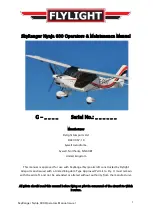
Rans Inc.
Section 6
Model S-7LS COURIER
Normal Procedures
Original Issue
March 3, 2005
6- 14
If the takeoff is being made over loose impediments, advance the throttle slowly. This
will allow the aircraft to be well into the takeoff roll before high propeller RPM's are
reached, and decreases the possibility of propeller damage. The rate the throttle is
advanced must be dictated by the available runway and obstructions in the departure
path.
Flap Settings
Normal takeoffs are accomplished with flaps up or half. Using half flaps reduces the
ground roll and the total distance to clear an obstacle.
If half flaps are used for takeoff, they should be left in that position until all obstacles are
cleared and a flap retraction speed of 60 MPH, and minimum altitude of 100 feet AGL, is
reached.
The pilot must always be prepared for an engine/power system failure and
ensure there is always sufficient altitude, airspeed, and a suitable landing site to
perform an "Emergency Landing Without Power".
Short Field Takeoff
Short field takeoffs are performed with half flaps. An obstacle clearance speed of 55
MPH should be used.
Crosswind Takeoff
Takeoffs in crosswinds of 5-15 MPH (4-12 kts) normally are performed with the minimum
flap setting necessary for the field length in order to minimize the drift angle immediately
after liftoff. The aircraft is accelerated to a speed slightly higher than normal, then pulled
off a bit more abruptly than normal to prevent possible settling back to the runway while
drifting. When clear of the ground, neutralize controls as required for coordinated flight
and turn the airplane into the wind to correct for drift. At the beginning of the takeoff roll,
it is advisable to apply aileron control into the wind.
ENROUTE CLIMB
A normal enroute climb is performed at 65-80 MPH with flaps up. Operation above 5500
RPM is limited to 5 minutes. Monitor engine temperatures and adjust climb speed as
required. A higher climb speed will provide better engine cooling.
CRUISE
Normal cruise is performed between 4500 RPM and 5500 RPM. The fuel consumption,
speed, and range will vary according to the particular power setting selected. A good
number for your cross- country planning is 2.65 hrs (2 hrs and 40 minutes) endurance
plus 30 min reserve.
In your cross country planning always consider that the weather and wind can change.
Plan accordingly and leave yourself room for alternate procedures.















































